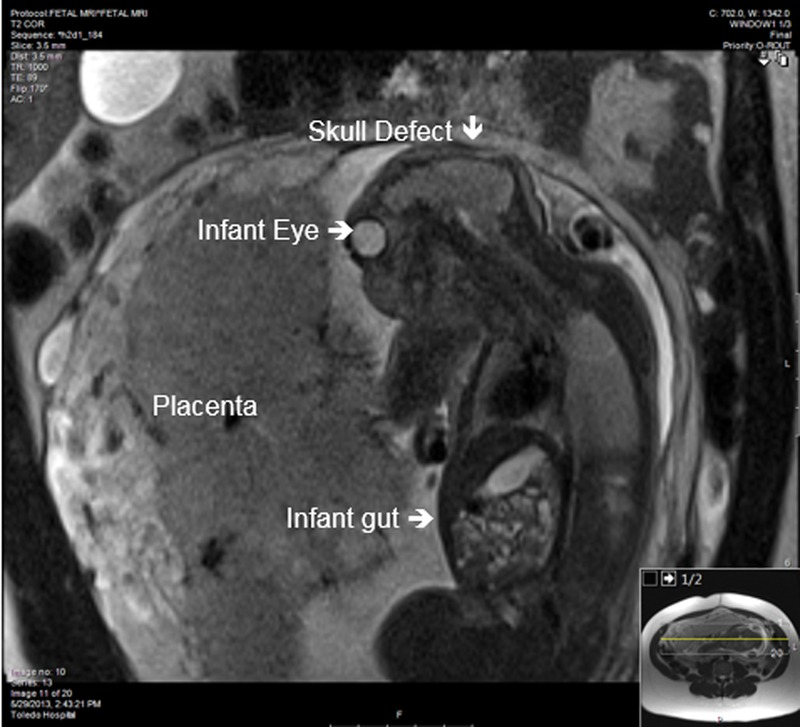Last semester, I was able to shadow a family medicine doctor, and I was presented with this rare case of a pregnancy that was anencephalic. Anencephalic is a congenital disorder, a birth defect that causes the baby to not develop a brain or skull (Cleveland Clinic, 2023). Studies have shown that this is such a rare case, 1 in 4,600 babies are diagnosed with anencephaly in the United States, however this is because this disorder affects the nervous system by not developing the neural tube that forms the brain and skull in the first month of pregnancy (CDC, 2023). The brain being essential to the body, and need for life as it pertains to functions like memory, body movement, and emotion.
The diagnosis for anencephaly is still unknown, but it is usually detected within the pregnancy though an ultrasound or blood test suggesting that there are levels of high alpha-fetoprotein, opioid use, and high heat exposure ( Cleveland Clinic, 2023). There are three different types of anencephaly: meroacrania, holoanencephaly, and acrania. According to Children’s Hospital, meroacrine is the milder form of this disorder and small area of the skull missing, acrania is the entire skull is missing and part of the brain is developed: while the holoprosencephaly is where the entire brain is missing (Children's Hospital Colorado, 2023).
Therefore, there seems to be a rare case for survival of babies with this congenital disorder, but there was one case that lived up to 28 months. This baby was a female infant born by C-section at 40 weeks and 2 days of gestation. As she reached the 28 months of life, she continuously got check ups, and it was noticed that the infant slept during the day and had an irregular heartbeat ( PubMed Central, 2016). This infant would smile occasionally and make cooing noises, but would obtain seizures as she got closer to the end of her life (National Library of Medicine, 2016). This was in result to not having a brain that allowed her to have emotions, form memories; but instead due to no structure in the brain, she obtained a lot of seizures.
As this case was rare, it became information that defied the current research on babies with this birth defect, that gave us a glimpse of the physiological effects that anencephalic disorder brings to the medical field. There are no treatments for this congenital disorder, and it is recommended to have a support system that can help with a family member with this condition.
Work Cited:Anencephaly. Children’s Hospital Colorado. (n.d.). https://www.childrenscolorado.org/conditions-and-advice/conditions-and-symptoms/conditions/anencephaly/
Centers for Disease Control and Prevention. (2023, June 28). Facts about anencephaly. Centers for Disease Control and Prevention. https://www.cdc.gov/ncbddd/birthdefects/anencephaly.html
Dickman, H., Fletke, K., & Redfern, R. E. (2016, October 31). Prolonged unassisted survival in an infant with anencephaly. BMJ case reports. https://www.ncbi.nlm.nih.gov/pmc/articles/PMC5093842/
professional, C. C. medical. (n.d.). What is anencephaly?. Cleveland Clinic. https://my.clevelandclinic.org/health/diseases/15032-anencephaly

This is a very interesting topic, and it was good to see your personal connection with the case you dealt with. One question I had regarding anencephaly was how the rest of the nerves in the body were impacted, if they were at all. You mentioned in the one case were the baby survived for 28 months that it exhibited some behaviors such as smiling and cooing that would be possible due to nervous system interactions. This is probably due to the varying levels of anencephaly wsuch as merocrania and acrania, but I was still curious about how other nerves may be affected. I did some more research and found that in some cases the brain stem is still in tact and connects to the rest of the nervous system, which could provide an explanation for the one baby that you mentioned. Overall, a very interesting topic to look at, and it is good that there is more research being done.
ReplyDeleteThis is very interesting. I have heard of anencephaly but I didn’t know there were specific types. Because these infants are born without a brain, would this mean they are born blind, considering they don’t have an occipital lobe? I found an article stating that babies with anencephaly are born blind, and also deaf as well. I wonder if this means that the infant you discussed was also blind and deaf?
ReplyDeleteU.S. Department of Health and Human Services. (n.d.). Anencephaly. National Institute of Neurological Disorders and Stroke. https://www.ninds.nih.gov/health-information/disorders/anencephaly#:~:text=Infants%20with%20this%20disorder%20are,Blind